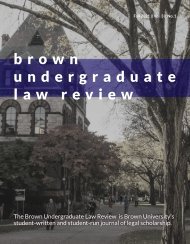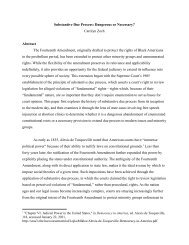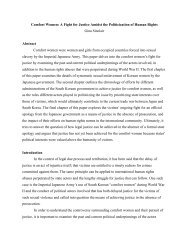Brown Undergraduate Law Review — Vol. 2 No. 2 (Spring 2021)
We are proud to present the Spring 2021 issue of the Brown Undergraduate Law Review. We hope that the works contained herein offer insight and inspiration to all who read them.
We are proud to present the Spring 2021 issue of the Brown Undergraduate Law Review. We hope that the works contained herein offer insight and inspiration to all who read them.
You also want an ePaper? Increase the reach of your titles
YUMPU automatically turns print PDFs into web optimized ePapers that Google loves.
The Failure of the Treatment of Low-Level Offenders in the Juvenile Justice System<br />
standardized discipline measures, police presence in<br />
schools increased, along with referrals to juvenile courts. 31<br />
Many of these policies first took hold in large<br />
minority-concentrated urban districts. As more young men<br />
However, for the states that allow incarceration on the<br />
valid court order (VCO) exception, the incarceration rates<br />
are greatly disproportionate for youth of color. 37 The VCO<br />
exception specifically circumvents the intent of the JJDPA,<br />
of color were shepherded into the to end the incarceration of status offenders, and has led to<br />
school-to-prison-pipeline, status offenses also criminalized<br />
anti-feminine behavior in women, such as promiscuity and<br />
alcohol consumption. 32<br />
As a result of centralized discipline policies, status<br />
offenders and low-level offenders began to crowd the<br />
juvenile justice system, paving the way for the federal<br />
Juvenile Justice and Detention Prevention Act (JJDPA) of<br />
1974. This law conditions federal grant money on the<br />
removal of detention sentences for status offenses. 33 In<br />
contrast to the law's intention, the JJDPA does not<br />
eliminate the detention of status offenders. The law allows<br />
for judges to use ?valid court orders? or mandatory<br />
conditions to students who plead guilty to a status<br />
the incarceration of over 7,000 status offenders annually.<br />
In 2014, 27 states continued to use this exception, with<br />
Utah using the VCO exception to incarcerate more than<br />
2,000 juveniles in one year. 38<br />
The Department of Justice Office of Juvenile Justice and<br />
Delinquency Prevention along with the National Council<br />
of Family and Juvenile Court Judges supported the repeal<br />
of the VCO exception for decades, based on the abundance<br />
of evidence that incarceration worsens outcomes for status<br />
offenders in school completion, mental health, and future<br />
job prospects. Incarceration is also costly, with secure<br />
detention costing on average $149,000 for one child per<br />
year. 39<br />
offense. 34 These conditions can include school attendance,<br />
It was not until 2018 that the JJDPA was reauthorized with<br />
curfew, substance abuse treatment, and any other measures<br />
stricter requirements for incarceration. The 2018<br />
the court deems fit. 35 Valid court orders are enforced with<br />
reauthorization, co-sponsored by Senator Chuck Grassely<br />
the threat of incarceration for failure to comply. Most<br />
(R-IA) and Senator Sheldon Whitehouse (D-RI), caps the<br />
states lack a statutory definition for valid court orders, and<br />
incarceration of status offenders at seven consecutive days,<br />
many states do not allow judges to use valid court orders.<br />
even with a valid court order. 40 The law also recognizes the<br />
These states follow the intentions of the JJDPA, and have<br />
disproportionate number of youth of color in the juvenile<br />
deemed that the distinction between status offenders and<br />
justice system and strengthens protections for girls,<br />
delinquents must be upheld. 36<br />
31. Ibid.<br />
32. Morris et. al.<br />
33. Ibid., 115.<br />
34. Juvenile Justice and Detention Prevention Act, Pub. L. <strong>No</strong>. 93-415, 42 U.S.C. § 5601 et seq., (1974).<br />
35. ?Use of the Valid Court Order,? SOS Project, Coalition for Juvenile Justice, <strong>No</strong>vember 21, 2020,<br />
https://www.juvjustice.org/our-work/safety-opportunity-and-success-project/issue-areas/vco.<br />
36. Gibbs, 126.<br />
37. Sawyer.<br />
38. ?Use of the Valid Court Order.?<br />
39. Jeffrey A. Butts and Douglas N. Evans, ?Resolution, Reinvestment and Realignment: Three Strategies for Changing Juvenile Justice,? John Jay<br />
College of Criminal Justice, City University of New York, (2011).<br />
40. Juvenile Justice and Detention Prevention Act, Pub. L. <strong>No</strong>. 93-415, 42 U.S.C. § 5601 et seq.<br />
<strong>Brown</strong> <strong>Undergraduate</strong> <strong>Law</strong> <strong>Review</strong><br />
12










